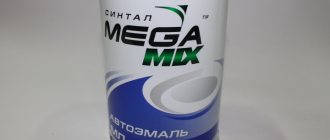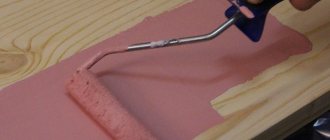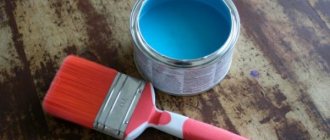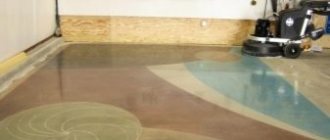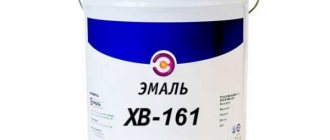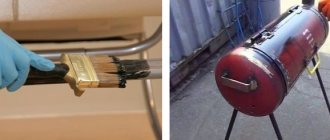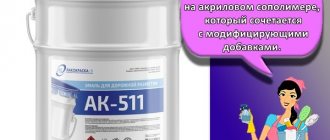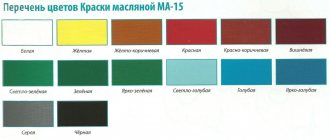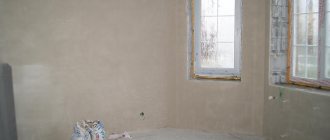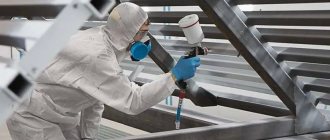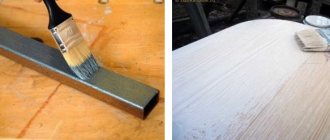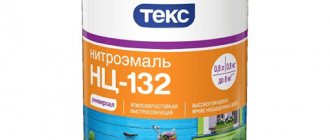In addition, PF 115 - the technical characteristics of which compare favorably with analogues in its high degree of elasticity, water resistance and resistance to ultraviolet radiation. These characteristics allow the enamel to be used for painting surfaces exposed to various types of atmospheric influences.
Composition and marking of PF-115 paint
High-quality enamel must meet all the requirements of GOST 6465-76. The PF marking indicates that the binding element of the enamel is pentaphthalic varnish, which is a modification of alkyd resin. Index 115 determines the area of paint use.
- Number 1 indicates that the enamel can be used for exterior painting in a wide climatic range;
- Index 15 is the serial number of the chemical compound used, the composition of which is regulated by the relevant GOST.
From a physical point of view, PF-115 enamel is a suspension consisting of dyes, titanium dioxide, pigments and other solid particles suspended in an organic solvent. The main component of the enamel is pentaphthalic varnish, which has high viscosity and plasticity.
Depending on the color, PF 115 paint may differ slightly in chemical composition:
| White | Blue | Gray |
| 1. Pentaphthalic varnish: 28% | 1. Varnish: | 1. Varnish: 20% |
| 2.Titanium dioxide: 62% | 2. TiO2: 60% | 2. TiO2: 75% |
| 3. White spirit: 10% | 3. Zinc white: 6% | 3. Carbon black: 0.5% |
| 4. Azure: 4% | 4. Solvent: 4.5% | |
| 5. Solvent: 4% |
The technical characteristics of PF-115 paint exactly correspond to the parameters given in the table, guaranteeing that the performance properties of the finished coating correspond to the parameters stated in the certificate.
Composition of pentaphthalic paint
The material includes:
- rutile type titanium dioxide TiO2 suspension;
- additional fillers to change fluidity;
- pigments that determine color (for example, yellow or black);
- driers that accelerate polymerization;
- alkyd varnish (solvent).
The percentage of components depends on the shade of the paint material. The ingredients are mixed at the factory in a special tank, and then the liquid is packaged with the batch number indicated. When purchasing several cans, you must select containers from the same series, otherwise you will need to mix materials in a tank with an increased volume. When applying paint produced in different work shifts, shade deviations are possible (allowed by the standard and not a sign of defects).
The pigments that make up the enamel determine its color.
Classification of enamel PF-115
Like other types of enamels, PF 115 is classified according to the following parameters:
- Areas of use;
- Composition;
- Physical and chemical properties;
- Appearance.
In addition, PF-115 paint can have different duration of complete drying. Red and cherry colored enamels require 48 hours to completely dry; grey, white and blue enamels reach their optimal performance parameters in 24 hours.
Characteristics of the Pension Fund of the Russian Federation
The legal regime of the Pension Fund is determined by the Regulations on the Pension Fund of the Russian Federation, approved by the Resolution of the Supreme Council of the Russian Federation of December 27, 1991 (as amended on August 5, 2000).
The Pension Fund of the Russian Federation is subordinate to the Government of the Russian Federation, to which it annually reports on the results of its activities. The Pension Fund budget is approved annually by the country's highest legislative body. The Fund's funds are state property. The fund is formed at the federal level and in the constituent entities of the Russian Federation, which allows payments to all pensioners, regardless of their previous place of work and place of residence.
The main objectives of the Pension Fund include the following:
— targeted collection and accumulation of funds for the payment of pensions and child benefits, as well as the organization of their financing;
— participation on a long-term basis in federal and regional financial programs for social support of the population;
— expanded reproduction of the fund’s assets based on the principles of self-financing;
— organization of a state data bank on payers of insurance contributions to the Pension Fund of Russia;
— deployment of preparatory work to organize individual accounting of mandatory insurance contributions received by the Pension Fund from working citizens;
— implementation of interstate and international cooperation of the Russian Federation on issues within the competence of the Pension Fund;
— participation in the development and implementation of interstate and international treaties and agreements on pensions and benefits.
The sources of education of the Pension Fund include:
— insurance contributions from employers;
— insurance premiums for citizens of the Russian Federation;
— allocations from the federal budget allocated for the payment of pensions and various types of benefits.
The management of the Pension Fund is carried out by the Fund's Board and its permanent executive body - the executive directorate.
The Board includes the Chairman, the first deputy, as well as managers of the fund's branches. The Board may also include representatives of public, religious and government organizations, associations, institutions and enterprises whose activities are related to the protection of the interests of pensioners, disabled people and children. Managers of PFR branches in the republics within the Russian Federation, heads of ministries and departments of the Russian Federation, and the Bank of Russia can take part in the work of the Pension Fund Board with the right of an advisory vote.
The Fund's Board is entrusted with: responsibility for performing functions within the competence of the Pension Fund; determining the future and current objectives of the fund; approval of the budget, cost estimates of the Pension Fund of Russia and its bodies, reports on their execution, as well as approval of its structure and staff.
To monitor the activities of the executive directorate of the Pension Fund and its regional bodies, an audit commission of the Pension Fund is formed. Enterprises, organizations, institutions, including banks, are required to submit to the authorized representatives of the Pension Fund the necessary documents and information related to the activities of the fund, with the exception of information constituting a commercial secret.
Scope of application of PF-115 paint
PF 115 enamel is used for painting a wide range of building and structural materials. The paint can be used as a protective coating for metal, wood, concrete, brick and many other materials, both outdoors and indoors.
Among the main areas of use of PF-115 enamel are:
- Mechanical engineering;
- Shipbuilding;
- Construction and repair work;
- Car manufacturing.
In all these industries, pentaphthalic enamels have proven themselves to be the best.
Advantages and disadvantages of the material
Like any material, this paint has its excellent qualities and flaws. To determine whether it is worth using it for painting work, you should understand them.
The advantages include:
- Good protective characteristics in relation to metal products;
- Acceptability of hygienic actions on a painted object;
- During use of objects, toxic paint elements do not evaporate;
- Budget cost.
The disadvantages can be described as follows:
- High abrasion rate;
- Emits a heavy odor when applied;
- May ignite during a fire.
Manufacturers are guided by GOST 6465-76 when producing paint. And information about industrial features and surfaces on which it can be used is indicated on the packaging.
Good protective characteristics against metal products.
Paint PF-115 – technical characteristics
Depending on the grade, the coating may have the following operational parameters:
| The name of indicators | Higher variety | First variety |
| Conditional viscosity | 80-120 | 80-120 |
| Amount of non-volatile substances, % | 57-68 | 49-68 |
| Permissible amount of solvent, % | 20 | 20 |
| Fraction of pigment particles, microns, no more | 15 | 25 |
| Complete drying time, h | 24 | 24-48 |
| Degree of adhesion, points | 1 | 1 |
In some cases, deviation from the specified parameters is allowed within 5%.
Cost of enamel
The average price of the material starts from 50 rubles. per 1 kg (for wholesale quantities weighing more than 1000 kg). A jar weighing 2.5 kg (manufactured by Tex) will cost a retail buyer 770-800 rubles. A tank weighing 0.9 kg has a cost in the range of 240-180 rubles. There are budget manufacturers (for example the Formula brand) offering 1.9-kilogram cans at a price of 390 rubles. Some building materials stores hold sales, in which case the buyer can save up to 10-15% of the starting price.
Enamel PF-115 consumption per 1 m2
Actual paint consumption depends on several factors:
- Chemical composition and color of enamel;
- Quality of surface preparation;
- Method of application;
- Temperature and humidity.
The table shows the consumption per 1 m2 of single-layer painting depending on the color of the enamel:
| Color | Consumption, kg/m2 |
| White | 0,1-0,14 |
| Black | 0,05-0,06 |
| Blue | 0,07-0,1 |
| Brown | 0,07-0,08 |
| Red | 0,1-0,2 |
From the above it follows that for enamel PF 115, the technical characteristics and consumption largely depend on the fraction of fillers and pigments, as well as the chemical composition. In addition, consumption may vary depending on the method of applying the enamel coating.
How long does oil paint take to dry?
- How long does oil paint take to dry?
- Solvents for removing old paint
- Floor paint for wood floors
How long does it take for painted surfaces to dry?
Oil paints are mixtures of drying oils made from natural oil or an artificial substitute, filler and coloring pigments (there are hundreds of shades of paints). They are used for painting wooden or metal surfaces (floors, walls, roofs, doors). Oil paint protects the surface from the penetration of steam or moisture. That is why this paint is often used to treat metal pipes and important structural elements of buildings.
How quickly the oil paint you choose dries depends on its formulation, humidity and ambient temperature, lighting and other external factors. Oil paint, unlike water-based paint, when drying, does not lose moisture, which is simply not present in the composition. An oil film appears on its surface due to oxidation processes. In order for these processes to occur faster, it is necessary to accelerate the interaction between the oxygen contained in the air and the paint surface.
How to paint
Experts advise carefully studying the composition of the paint indicated on the packaging. It is believed that a really good oil paint contains at least ten to twelve components. To ensure the formation of a stable oil film occurs faster, apply the paint with a brush or roller to a carefully prepared surface. On average, paint applied in a thin layer takes about a day to dry. If you do not like the unevenness of the coating or the presence of unpainted fragments, after the first layer has dried, apply another one; it will take a little longer to dry.
To speed up the oxidation process and the formation of a permanent film, you can heat the painted surface. For example, some artists, after completing their paintings, dry them using regular batteries. A heater or heater will speed up the drying of paint indoors. Heating makes the film stronger. Do not leave the heater unattended to avoid the risk of fire. If you are going to paint walls, floors or ceilings yourself, be sure to open the windows in the room, since oil paints are quite toxic and their fumes can seriously harm your health.
There are chemical accelerators for the drying process of oil paint. For example, you can add driers (or drying accelerators) to it. A small amount of them is required; you need to add driers to a can of paint, following the instructions on the package. After this, the resulting mixture must be mixed very thoroughly. Dryers significantly speed up the drying of painted surfaces, but do not affect the quality or density of oil paint.
How to dilute alkyd enamel PF-115
Before you start painting, you need to make sure that the paint has the required consistency. In practice, during long-term storage, the enamel often thickens, but you should not despair and go to the store for a new one. In most cases, it is sufficient to use a suitable solvent.
There are several main types of solvents:
- Petroleum based
. This type includes white spirit, orthoxyrol, gasoline and solvent. The scope of application of these solvents is oil-based varnishes and paints. - Organic solvents
such as xylene and acetone. Such solvents do not destroy the structure of paints and varnishes. - With chemical components
. The concentration of additives is reflected in the solvent labeling, for example: P-4, B-646, etc.
To give PF-115 enamel optimal performance characteristics, white spirit and solvent are most often used. Special formulations are more effective, but their cost is much higher.
The drying time of any type of paint coating is affected by temperature, relative air humidity, as well as the speed of air movement (wind, draft, use of a fan, etc.). At 18-200C, each layer requires 24 hours to dry.
Typical consumer problems when using paints and varnishes (using the example of PF-115, XV-16)
Working for several years as the chief technologist of Khimtek PA LLC, I repeatedly had to communicate with consumers of paint and varnish products, advise them in case of problems with the use of paints and varnishes
and, to be honest, deal with claims. Communicating with consumers, I noticed that problems that arise with consumers are not always caused by the quality of the paints and varnishes used. If the paintwork material does not meet the requirements of regulatory documentation, then everything is clear - it must be immediately returned to the manufacturer. But very often, problems that arise for consumers when using paints and varnishes are caused by ignorance of their properties and features, the rules for preparing the surface for painting, preparing the material for painting, violation of painting conditions, etc. Moreover, this is not some lofty matters and secret knowledge from the field of chemistry and coating technology, but the most basic things. And it looks even more strange when this lack of knowledge, and sometimes even obvious neglect of it, comes from experienced production workers, specialists with paint and varnish education, and experienced painters. On the other hand, the set of indicators described in GOST or TU in the quality passport does not cover the entire range of properties, characteristics and features of paintwork materials.
The most typical, frequently encountered problem that consumers encounter when using paints and varnishes can be expressed in one short phrase: “The material does not dry.” The answer question immediately arises: “How does it not dry out?” The concept of “does not dry” evokes completely different associations for different people - for example, a painted surface sticks after the paint has dried
- this is the same “does not dry”. But why doesn't it dry? If the primer or enamel does not dry within the time specified in the regulatory documentation, subject to the painting conditions - temperature, humidity, then the problem really is with the quality of the paintwork. But, for example, if this material is applied in winter in an unheated room at a temperature of +5 o C, then the problem is not in the quality of the material, but in non-compliance with the temperature regime. Paintwork materials, the drying time of which at a temperature of +20 o C is 24 hours, will not be able to dry at a lower temperature in the same time. Another important point is the humidity at which the material dries. It must be taken into account that at high humidity (more than 85%) the material takes longer to dry. In this case, in order to dry the paintwork faster, it is necessary to ensure an influx of warm, dry air into the room where painting or drying of the painted product takes place - for example, use heat guns or heaters. Or be patient.
Another version of this problem is possible, when the consumer assures that paintwork
“does not dry” - you come to investigate and see this picture: you touch the painted surface and do not feel the sticking effect, the surface layer of the coating is completely dry.
But the enamel is applied in a very thick layer and when pressed, the coating breaks down, it is soft. What happened? As a rule, when applying the material in a thick layer, the top layer dries in the allotted time, forming a continuous film that prevents solvent vapors from escaping from the thickness of the coating into the air of the working area. enamel
remains , and the coating itself, when pressed, creases and appears soft and “not dry.” What should I do to avoid this problem? Either apply the material in a thinner layer, or, if it is necessary to obtain a thick-layer coating, apply paintwork materials in several layers with mandatory inter-layer drying. By the way, a similar problem may arise in the case of painting an uneven, non-uniform surface - in places of welding seams, joints of planes, in the presence of grooves, recesses and dents - i.e. where the thickness of the paint layer also naturally changes upward.
Which roller is best for PF 115 paint?
The paint roller is a universal design that consists of the following elements:
- ·Byugel – a metal bracket for fastening a roller with a fur coat;
- · Ergonomic handle that allows you to securely hold the roller during operation;
- ·Roller that can rotate freely;
- ·Fur coats. Depending on the requirements for the surface to be painted, there are different types of coats.
The best results when applying PF-115 enamel are provided by polyamide, polyacrylic and velor.
How long does acrylic paint take to dry?
Acrylic paint is popular in various fields due to its exceptional properties.
The resins included in the paint coating give the painted surface a decorative appearance that is resistant to fading in the sun and aggressive environmental influences. Acrylic paints dry quickly, and therefore are widely used in external and internal works, for hobbies and painting.
How long does acrylic paint take to dry?
Drying of acrylic directly depends on the surface being painted. Thus, smooth materials (metal, glass, plastic) take longer to dry than porous materials (cardboard, concrete, wood, paper, fabric, etc.). The initial hardening of the layer takes on average 0.5-2 hours, depending on the thickness. For example, acrylic paint VD AK 111, intended for painting buildings and premises of any type, dries within an hour. Full strength gain occurs in approximately 30 days. The drying process is accelerated if favorable conditions are created:
If you plan to apply several layers, then each subsequent one increases the “setting” period.
Acrylic paints have dried out - what to do?
Knowing how long acrylic paint takes to dry, it’s easy to guess that a poorly closed container will cause damage to the paint product.
In some cases, the dried composition can be diluted with water and returned to its original state, with the exception of situations where the paint was previously frozen. True, you can no longer expect a perfect result and the original brightness - acrylic that has dried in a jar is difficult to restore. At a temperature of 20-25 degrees, a thin layer of paint stops sticking to your hands after 30 minutes. More intensive application requires 2 hours to dry. At the same time, it is not recommended to test the “strength” of a painted surface for at least a day. When the air temperature is below 10 degrees Celsius, working with acrylic paints is not recommended - the drying period will take a long time.
How to dilute dried acrylic paint?
If the paintwork has dried to a rubbery state, you can try diluting it slightly with water directly in the jar. There are several more ways to “bring back to life” the composition, but the result of coloring is difficult to predict. So:
- You can purchase a special acrylic paint thinner,
- Solvent and white spirit are effective,
- A labor-intensive method: crush the paint into powder and heat it in a water bath (or dilute it with boiling water). You can use alcohol instead of hot water.
These manipulations will help you obtain the desired consistency, but most likely the shade will fade and the coating will no longer be as even. Experts recommend not wasting time on “reanimating” dried acrylic, because... It is virtually impossible to achieve good adhesion to the surface and its former strength after drying.
Technological process of applying PF-115 enamel
Depending on the type of surface, painting technology may be different.
Metal painting
. First of all, it is necessary to mechanically remove rust, and treat the remaining corrosion defects with an inhibitor. After this, the surface is treated with primer GF-0119 or a similar composition. Painting is done in two layers with an interval of 24 hours.
Wood staining
. PF-115 enamel, the main technical characteristics of which are completely suitable for painting surfaces made of natural wood, is applied in 2-3 layers depending on the absorbency of the material; the use of primers, in this case, is optional. Pre-treatment with antiseptic compounds compatible with pentaphthalic enamels is possible.
Painting plaster, brick and concrete
. To obtain a high-quality coating, 2-3 layers are needed. Before applying enamel, it is advisable to use antiseptic compounds to prevent the appearance of fungus and mold. The relative humidity of the surfaces to be painted should be between 10 and 15%.
How to paint correctly with PF 115 paint video
During painting work, PF 115 paint must be stirred regularly to prevent the formation of sediment.
Learn more about use
Before starting use, you should familiarize yourself with:
- safety regulations;
- a list of solvents and enamel dilution technology;
- mass consumption of material per 1 m² of surface (to calculate the need);
- a list of tools and devices necessary to perform the work;
- rules for applying and choosing a paint scheme;
- standards for selecting the type of paint depending on the characteristics of surfaces;
- storage conditions of the material.
Safety precautions
Basic rules when using paint:
- Since the material contains organic solvents, the enamels of the PF-115 series belong to the category of fire hazardous and toxic substances. For example, turpentine vapors ignite already at +34°C, and spontaneous combustion occurs when heated to +300°C. When applying with a brush or spray gun, the use of open flame sources is not allowed.
- Emitted vapors of solvents penetrate the human body through the mucous membranes of the eyes, skin and respiratory tract. Work must be performed in ventilated areas using protective clothing and a respirator. To ensure air exchange, it is allowed to use artificial ventilation (for example, an electric hood). Indoors, it is necessary to open windows and doors; the risk of street dust or fluff from plants sticking to painted surfaces should be taken into account.
- The components contained in the material must not enter the sewerage system, onto the ground or into water bodies. The remaining paint must be disposed of in metal packaging as hazardous waste. If the container is cleared of traces of enamel, then disposal of the products together with household waste is allowed.
- If spilled paint ignites, it is necessary to use sand or a felt made of non-flammable fabric material to extinguish. It is permissible to use foam or carbon dioxide fire extinguishers or sprinkler extinguishing systems with a spray of tap water.
It is strictly forbidden to use enamel near an open flame source.
Dilution of pentaphthalic enamel
Manufacturers supply the paint ready for application, but during long-term storage or before refilling the sprayer, the material must be diluted. Thick enamel clogs the nozzle channels and does not provide uniform coverage of surfaces.
The volatility of the solvent has a slight effect on the hardening time (deviation within 2-4 hours). For PF-115, petroleum-based liquids (for example, solvent or white spirit) or special materials RE-4V or RE-3V are used.
Sequence of actions for breeding:
- Open the paint container and mix the material by hand or with an electric mixer.
- Add solvent; if the volume of the factory container is insufficient, then the components must be poured into a container with increased capacity.
- Stir the solution until a homogeneous mass is obtained. Pigment clumps are not allowed, since lumps clog the spray nozzle and reduce the quality of the coating when using a brush or roller. It is recommended to use an electric drill with a mixer. With a manual technique, clots may remain in the structure of the material. Select the rotation speed of the device experimentally; the tool should not splash paint over the edge of the container.
Paint consumption depending on shade
When using PF-115, you should take into account the floating consumption when painting, depending on the shade. The reason for the different results is the uneven size of the filler fraction. Material costs are influenced by the application method and surface characteristics. For example, untreated wood, brick or porous concrete will absorb some of the enamel, requiring a repeat pass with a brush or spray.
Required Tools
To apply the paint layer the following can be used:
- brush with synthetic or natural bristles - the width is selected depending on the size of the surfaces;
- felt roller with a standard handle or with an extension rod for painting walls at a great distance from the ground;
- pneumatic spray gun with electric compressor and pressure regulator;
- baths with liquid paint and a manipulator that immerses parts in the solution (used in industrial settings).
When processing surfaces, a separate paint reservoir may be required (for example, to ensure uniform wetting of the roller). To prepare liquid enamel before filling it into the spray tank, you will need a container with a volume of 1-2 liters. When painting indoor surfaces, it is necessary to use a protective material for the floor or interior items (for example, plastic film or old wallpaper).
To apply the paint layer, it is recommended to use a brush with synthetic or natural bristles.
Rules for working with paint
When applying the coating you must:
- Inspect surfaces that are free from oil stains or traces of moisture. Please note that painting is carried out at a relative air humidity of less than 80%. It is not allowed to use the material in cold weather (minimum ambient temperature +5°C). If the requirements are violated, the polymerization time increases and adhesion deteriorates.
- If there is dirt on the surface or peeling of the old paint coating, it is necessary to clean it (for example, using an abrasive tool). Wooden products should be impregnated with antiseptic primer to prevent rotting and mold formation. If work is carried out indoors, then use diluted enamel as a primer (solvent share no more than 10%). Clean metal structures with sandpaper or steel brush from traces of corrosion, wash with a degreasing compound and apply a layer of primer.
Painting schemes
Since PF-115 enamel is universal, application of the material in any direction is allowed. The master needs to control the uniformity of the layer on the surface and avoid the formation of clots. It should be noted that liquid paint can flow down vertical or inclined walls during the hardening process, so you should control the volume of applied enamel.
Selection of enamel depending on the surface
If the base has a dark shade, then several layers of enamel will be required. Otherwise, after polymerization, unpainted areas may remain on the surface.
A second coat requires 10-15% less enamel, but before applying it is necessary to wait 24 hours for the primary coating to polymerize.
When using a spray gun, some of the material is sprayed into the air, which leads to increased paint consumption, but provides a smooth surface without foreign inclusions (for example, brush lint).
Storage conditions
Packaged in sealed containers, the paint can withstand transportation and storage in rooms with negative air temperatures. Frost resistance is not regulated by the standard, but the material should not be cooled to -20°C or lower. Storage near heat sources is not allowed, since at elevated temperatures some of the solvent evaporates with the formation of clots or a dense film on the surface. Manufacturers allow paint to be stored for 24 months from the date of packaging, subject to climatic conditions.
Enamel PF-115 consumer reviews
Despite the fact that there are also negative reviews, the vast majority of respondents are satisfied with the performance properties of PF-115 enamel. In addition, the price/quality ratio provides this type of pentaphthalic enamel with increased demand among the middle class of consumers. Domestic alkyd enamels, manufactured in accordance with GOST, are not inferior to foreign analogues, and are much cheaper. In most cases, negative reviews are associated with the purchase of “pirated” products, improper use of solvents, or violation of painting technology.
GOST and certificate of conformity
Oil paint PF-115 is produced in accordance with GOST 6465, developed by the USSR Ministry of Chemical Industry. The standard was put into effect in mid-1977 by a resolution of the State Committee for Standards. Over the subsequent years, the documentation has undergone several editions; the adjustments made did not affect the standard number.
Each manufacturer receives a certificate with a limited validity period. The document confirms the compliance of paints and varnishes with the requirements.
Some companies issue certificates in accordance with Russian GOST R 51691-2008, which describes the general requirements for paints and enamels (on any basis). Regardless of the standard, the document indicates the name and address of the manufacturer and a list of test reports. The additional field lists the timing of inspection control (to verify compliance of production conditions and product characteristics with requirements).
Which manufacturer is better?
Without exaggeration, PF 115 enamel can be called legendary, which is why a large number of enterprises are engaged in its production. Below are the results of tests conducted by independent experts.
The drying time of enamels produced by POLIFARB and ZEBRA is practically the same and ranges from 20 to 23 hours, in addition, these enamels are easy to apply;
In the process of painting with enamels produced by DekArt, BARVA and DELFI, problems arise with uniformity of coloring, elimination of drips, streaks and brush marks;
All manufacturers provide high quality gloss, but special mention should be made of ZEBRA and MALVA;
Reliable information on paint consumption is provided by ZEBRA and MALVA.
The tests were carried out on the basis of the Physico-Mechanical Institute named after. G. V. Karpenko NAS of Ukraine.”
Depending on the color and class of enamel, the price of 1 kg can be from 60 to 170 rubles. You can find out more about the prices for the required paint on the website of the online store whose services you have decided to use.
Precautionary measures
When working with alkyd enamels, in particular with PF 115, the following precautions must be observed:
- The paint should be stored in airtight packaging;
- Take measures to ensure fire safety;
- Carry out painting work with protective rubber gloves;
- Avoid inhaling enamel fumes;
- After completion of work, ensure thorough ventilation of the room for 2-3 days.
Taking into account the above facts, we can conclude that alkyd enamel PF-115, developed in the USSR back in the 70s of the twentieth century, has not yet lost its relevance. The ability to use when painting any surface, the high quality and appearance of the resulting protective and decorative coatings ensured the wide popularity of the paint among the average consumer.
Video demonstration of removing PF-115 enamel using RIPAG remover
In addition, the favorable price/quality ratio allows domestic alkyd enamels to successfully compete with leading foreign manufacturers.
Tools needed for painting
The solution can be applied with a wide brush, roller or pneumatic spray gun.
The choice depends on personal preference, but a sprayer will require more solution (and this is an extra expense).
If you choose a brush, you will spend more time on the work. Painting with a roller is faster and more economical.
When using a spray gun, you need to make a thinner consistency (if you need to paint large sheets). For smaller parts, a roller or brush is suitable (mainly for thin gates).
You need to work quickly with the spray gun - fill the container with the solution as soon as it runs out, and treat the surface without stopping so that the mixture does not have time to dry.
The second layer must be applied after the first has dried (in a day).
You can paint with aerosols, but they are much more expensive, although they are convenient to use.
Working with a brush on metal is the most unprofitable - drops of paint flow down, stains remain, and more material is wasted. The advantage of the brush is that it will fit into all the cracks and cover all the hard-to-reach places.
The best choice is a roller. The layer is applied evenly and not much paint is wasted.
After cleaning the structure from dirt, apply a thin layer of primer to the part (the surface must be dry). It is better to treat with 2-3 layers of soil mixture.
